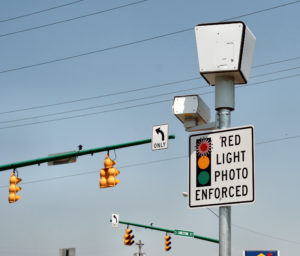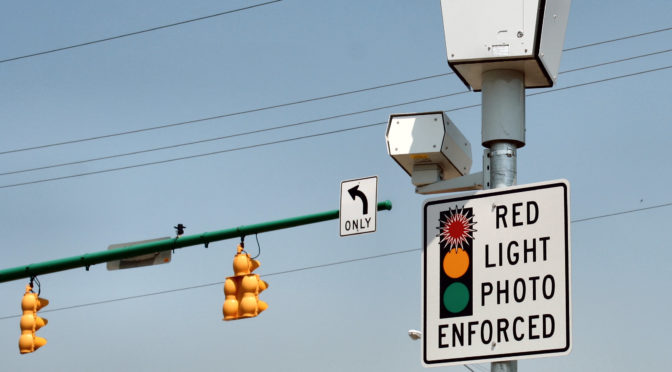
If you’re like most drivers in the United States, you probably have a negative opinion of red light cameras, especially those close to where you drive. Sure, on the surface, the idea of cameras to catch people running red lights might not sound like a good idea, but everyone really knows they’re just around to catch people and give tickets, right?
Not at all. The truth is that red light camera programs are actually quite effective in reducing instances of red light running, as well as fatal crashes resulting from red light running. But how much of an issue is this? How many people are actually dying, how effective are the cameras, and how do we keep our loved ones safe in a political climate where people and legislators are opposed to technology that makes us safer? Let’s take a look together below.
How many people die or are injured from red light running crashes?
Per FARS data, in 2014, 709 people died from crashes involving red light running, while an estimated 126,000 were injured. Given that there were 32,675 deaths overall, the 709 made up a small (2%) fraction, but still a needlessly large one. One out of every 50 traffic deaths resulted from individuals attempting to cross an intersection when the light system indicated they no longer had the right of way.
Do the red light runners die more often, or the people they hit?
Sadly, the primary victims of red light runners are rarely the runners themselves; per the IIHS, the majority of victims are either people occupying the vehicles impacted by the vehicle without the right of way, passengers in the vehicle without the right of way, pedestrians, or cyclists.
Do red light cameras actually reduce red light running and fatalities?
Yes! When enforcement is automated, drivers are less likely to run lights. This is more effective than traditional police enforcement, since it occurs 24 hours a day without the need for officers at given intersections. Cameras also serve as greater forms of deterrence when made public, and also have much better “vision” than manual methods, since they’re always at their intersections. Per the IIHS, red light running fatalities decreased by 21% in cities with activated cameras compared while all kinds of fatal crashes at intersections with signals decreased by 14%. The general decrease at signalized intersections was hypothesized to greater overall caution by drivers cognizant of the presence of cameras in other areas of town.
What happens when red light cameras are removed?
In contrast, when red light cameras were turned off in cities, rates of red light running fatalities increased by 30% while all signalized intersection fatalities increased by 16%. To put it simply, when cameras are removed, drivers revert to old, unsafe, and potentially deadly habits. Cameras make the roads safer for everyone. But opposition to them makes the roads more dangerous for all of us.
What can I do to keep my family safe from red light runners?
Unfortunately, there’s very little you can do to protect your loved ones from red light runners at an individual level, as this is another one of the many societal problems that needs societal solutions. Just as we can’t fully inoculate ourselves from the effects of drunk drivers or speeders, there’s only so much we can do individually to keep our loved ones alive in a driving culture where driving isn’t taken seriously.
To keep people safe in general from red light runners, we need to reduce a culture of disregard for safety and increase a culture of respect for the road. Ideally, this might be achieved by educating people of all ages of the advantages of following traffic laws, but practically, we’re most likely to stop red light running when the vast majority of vehicles on the road are autonomously controlled. I’ll discuss this below before providing individual solutions.
Why would autonomous cars eliminate red light running fatalities?
The reason autonomous cars are the technological solution most likely to eliminate fatalities from running red lights is because self-driven vehicles (truly self-driven ones, not Teslas on “Autopilot”) don’t run red lights. They’re programmed to behave like regular drivers to varying degrees, but they’re also programmed to avoid breaking blatant traffic laws, unlike human drivers. As with vaccines, however, for full effectiveness, you need the vast majority of individuals (in this case, vehicles) in a population to be inoculated (or in this case, self-driven).
Even before reaching a critical mass of autonomous vehicles where enough people began to use them to make their adoption inevitable, you’d still be much safer in a self-driving car at a red light intersection than in a regular one, as an autonomous car would have an array of camera, radar, and laser systems to help detect and avoid perpendicular traffic at intersections.
Until self-driving vehicles are available, what can I do for my family’s safety on an individual level?
My general suggestions for reducing your loved ones’ odds of injury or death in traffic collisions are closely tied to my specific suggestions for avoiding red light collisions. The best solution is to avoid driving entirely; since self-driving vehicles aren’t currently on the market and will likely not be for at least some years to come, I’d recommend using public transportation (i.e., buses and trains) as much as possible. Due to their sizes, both kinds of vehicles are essentially immune to red-light runners, and your odds of survival without death or serious injury are much higher in buses and trains.
If you can’t use public transportation, which is the case with many in the US, my next suggestion would be to exercise extreme caution whenever entering an intersection that has recently turned “green.” Having the right of way doesn’t immunize us from the possibility of being broadsided by inattentive or negligent drivers, and taking a second or two to survey the intersection you’re about to cross on a fresh green life could save your life.
Finally, I’d recommend making sure that whatever you’re driving is equipped with side airbags with head and torso protection at a minimum if a driver, and at least head protection for rear passengers. Ideally, the vehicle should also feature a “good” side impact score from the IIHS. This doesn’t guarantee you’ll survive a red light collision if you’re unlucky enough to be involved in one, but it does significantly increase your odds of doing so, especially if you’re impacted by a vehicle weighing around 3,300 lbs or less (e.g., a mid-sized car or small SUV) and traveling at 31 mph or less, as this is exactly the kind of crash the IIHS’ side impact test is designed to simulate. My side impact resistance guides for small cars, cars overall, SUVs, small SUVs, and minivans address the leading vehicles in impact resistance.
What about rear-facing vs forward-facing? Does that impact red light running crash safety for kids?
Absolutely! A red light running crash is almost always a side impact collision, or a t-bone, and, as with almost every crash situation, it’s safer to be rear-facing during one than it is to be forward-facing, as the forward momentum of your vehicle will drive a child further into a rear-facing car seat (as opposed to directly out of a forward-facing car seat), giving the sides of the seat a much greater chance to protect the child from the forces (and potentially the intrusion) of the impacting vehicle. Once again, rear-face to the limits. The Fllo, Foonf, Rainier, Pacifica, and Extend2Fit make it easy to reach 5 year or 50 pounds before forward-facing.
—
If you find the information on car safety, recommended car seats, and car seat reviews on this car seat blog helpful, you can shop through this Amazon link for any purchases, car seat-related or not. Canadians can shop through this link for Canadian purchases.


